The hydrology cycle and the environment
Understanding the everyday essential process, and the vital role plants play
The hydrological cycle, also known as the water cycle, is a natural process that is fundamental to life on Earth. This continuous cycle involves the evaporation of water from the Earth, the formation of clouds, precipitation, and the return of water to land and sea surfaces. Water is a precious resource that supports biodiversity, agriculture and human life. However, inefficient use and poor management of water resources can lead to serious social problems such as droughts, floods and water shortage. Plants, as well as infrastructure such as reservoirs and water basins can play a crucial role in creating local hydrological cycles, helping to solve some of the most pressing water-related challenges and improving environmental sustainability.
The Earth is a complex and dynamic system, in which all its components, such as clouds, oceans, mountains, volcanoes and living organisms, are interconnected and influence each other. This system, called the ‘Earth system’, is made up of different ‘spheres’: the geosphere (solid earth), the hydrosphere (water), the cryosphere (ice), the biosphere (living beings) and the atmosphere (air) . These spheres interact with each other through chemical, physical and biological processes, regulated by cycles such as the hydrological cycle.
Water, present in all three of its physical states (solid, liquid, gas), plays a crucial role in shaping the Earth’s landscape.
In solid form, water manifests as ice and snow, covering polar ice caps and mountain peaks, in liquid form, water is present in oceans, lakes, rivers and streams, forming the basis for marine and terrestrial life, and in gaseous form, water is found as water vapor in the atmosphere. The transition between these states through warming and cooling is critical to the water cycle, which supports ecosystems and life on Earth. The water cycle, powered by solar energy, guarantees the continuous movement and exchange of matter and energy between the spheres.
The phases of the hydrological cycle
1. Evaporation
Evaporation is the process by which water changes from a liquid state to a gaseous state. This occurs mainly from oceans, which cover about 71% of the Earth’s surface, but also from lakes, rivers and moist soil. Solar energy heats water molecules, giving them enough kinetic energy to escape the liquid’s surface and turn into water vapor. This process is crucial because it is the main mechanism that allows water to enter the atmosphere.
2. Condensation
Condensation is the transformation of water vapour into droplets of liquid water, which occurs when water vapour cools in the atmosphere. This cooling can occur for several reasons, such as the rise of warm air that expands and cools, or contact with cold surfaces. The droplets aggregate around microscopic particles of dust, sea salt or other impurities in the air, forming clouds. Condensation is essential because it represents the next step that allows water to return to the Earth’s surface in the form of precipitation.
3. Precipitation
Precipitation is the process by which water, in the form of rain, snow, hail, or fog, falls from the troposphere to the Earth’s surface. This phase begins when water droplets in the clouds become large enough to overcome air resistance. The coalescence of droplets and ice crystals causes the particles to increase in size, until they are heavy enough to fall to the ground. Precipitation distributes water over land and water basins, providing water needed for terrestrial ecosystems and human use.
4. Infiltration
Infiltration is the process by which precipitated water penetrates the soil and moves through the surface layers of the soil. The speed and quantity of infiltration depend on the permeability of the soil, the vegetation present and the intensity of rainfall. Infiltrated water can recharge underground aquifers, helping to keep freshwater reserves usable by plants, animals and human activities. Additionally, during infiltration, the water can be filtered naturally, removing impurities and improving water quality.
5. Runoff
Runoff occurs when precipitation exceeds the soil’s absorptive capacity and flows over the Earth’s surface. This surface water flow heads towards rivers, lakes and oceans, carrying sediments, nutrients and sometimes pollutants with it. Runoff is a critical component of the hydrologic cycle because it helps distribute water over large geographic areas. However, it can also cause soil erosion and flooding if it occurs in excess or on poorly permeable soils.
6. Transpiration
Transpiration is the process by which plants release water vapor into the atmosphere through the stomata of their leaves. This phase is part of the hydrological cycle also known as evapotranspiration, which includes both evaporation from the soil and water surface and transpiration from plants. Transpiration helps regulate plant temperatures and maintain the flow of nutrients through plant tissues. It also contributes significantly to atmospheric humidity aiding the formation of clouds and subsequent precipitation.

The effects of global warming on the earth’s hydrological cycle
Climate change has a significant impact on the hydrological cycle, influencing various key processes such as evaporation, precipitation and stream flow.
Rising global temperatures, caused by the greenhouse effect, intensify evaporation from oceans, lakes and rivers. A warmer atmosphere can contain a greater amount of water vapour, which leads to an increase in atmospheric humidity.
Increased evaporation leads to increased global precipitation. However, the distribution of this precipitation is not uniform. Some areas, such as high latitudes, experience an increase in precipitation, while others, such as the tropics and subtropics, may see a decrease.
A warmer atmosphere not only increases the amount of water vapour, but also makes the hydrological cycle more energetic. This leads to more intense rainfall and frequent extreme weather events, such as floods and droughts. Drought periods tend to become longer, while rainfall events become more intense, a phenomenon known as “hydrological cycle intensification”.
Climate change also affects the hydrological regime of rivers and lakes. For example, in mountainous areas, rising temperatures lead to a reduction in seasonal snow cover and an earlier snowmelt period. This leads to an increase in river flows in autumn and winter and a decrease in spring and summer.
According to the data, there has been a significant increase in the number of climate-related catastrophic events, such as floods, droughts and heat waves, in recent decades.
The UK has seen a significant increase in extreme weather events, which have been widely attributed to the effects of climate change. A study by World Weather Attribution (WWA) has shown that average rainfall on stormy days in the UK has become around 30% heavier compared to pre-industrial climates, which were 1.2°C colder. This increase is belived to be due to human-induced climate change. According to the Met Office, the UK’s heat waves have become more frequent and intense. For example, the summer of 2022 was one of the hottest on record, with temperatures exceeding 40°C for the first time. The UK has also experienced an increase in river and coastal flooding. The 2021 Committee on Climate Change (CCC) published their report, highlighting that the risk of flooding has increased significantly due to rising sea levels and heavier rainfall.
Despite the increase in heavy rainfall, the UK has also seen more frequent and prolonged droughts. The Met Office reported that 2022 saw one of the most severe droughts in decades, with significant impacts on agriculture and water resources.
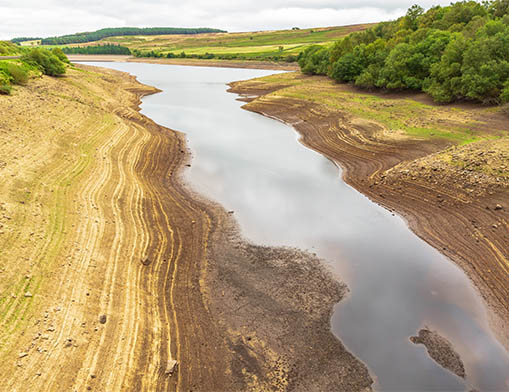
August 2022 – Leighton Reservoir in Nidderdale, North Yorkshire, UK
Role of plants in the hydrological cycle
Plants play a crucial role in the hydrological cycle, helping to maintain the balance of water on Earth. They actively participate in the water cycle through the process of transpiration. During photosynthesis, plants absorb water from the soil through their roots, before releasing it into the atmosphere as water vapour through pores in their leaves, known as stomata.
Plants, especially those with deep roots, help retain water in the soil. The roots create channels in the soil that improve the infiltration of rainwater, reducing surface runoff and increasing aquifer recharge. This is especially important in drought-prone areas, where this water-holding capacity can make the difference between fertile and barren soil.
Plant roots act like a net that stabilises the soil, preventing erosion caused by wind and water. Plants, such as shrubs and trees, are particularly effective in this role. Plant cover reduces the impact of raindrops on the ground, reducing soil breakdown and the risk of erosion. Plant leaves also slow the flow of rainwater, allowing better infiltration and reducing surface runoff.
The following plants contribute significantly to maintaining the natural hydrological cycle, improving water management and preventing soil erosion:

Betula pendula
Salix alba
Salix alba is known for its ability to absorb large quantities of water, making it ideal for wet areas and for stabilising stream banks. Its extensive roots improve water infiltration into the soil, reducing surface runoff and preventing erosion. Salix alba is also used in phytoremediation, which is a natural approach to removing contaminants from water.
Betula pendula
Betula pendula has deep roots that improve water infiltration into the soil. It is particularly useful for preventing erosion and improving soil structure. Its falling leaves contribute to the formation of humus, improving soil fertility.
Quercus robur
Commonly known as oak, they have deep roots that help retain water in the soil and prevent erosion. They are also effective in improving groundwater recharge. Quercus robur provide dense leaf cover that reduces the impact of raindrops on the soil.

Quercus robur
Alnus glutinosa
Alnus glutinosa is often used for wetland restoration. Its roots improve soil structure and help prevent erosion. It is a pioneer plant that rapidly colonises disturbed soils, improving soil quality.
Corylus avellana
Corylus avellana has a root system that helps stabilise the soil and improve water infiltration. It is also useful for preventing erosion in hilly areas. Its falling leaves contribute to the formation of humus, improving soil fertility.
Crataegus monogyna
Crataegus monogyna is a deciduous shrub, whichgrows well in a variety of soil conditions, with roots that help improve soil structure and prevent erosion. It is also known for attracting pollinators, contributing to biodiversity.
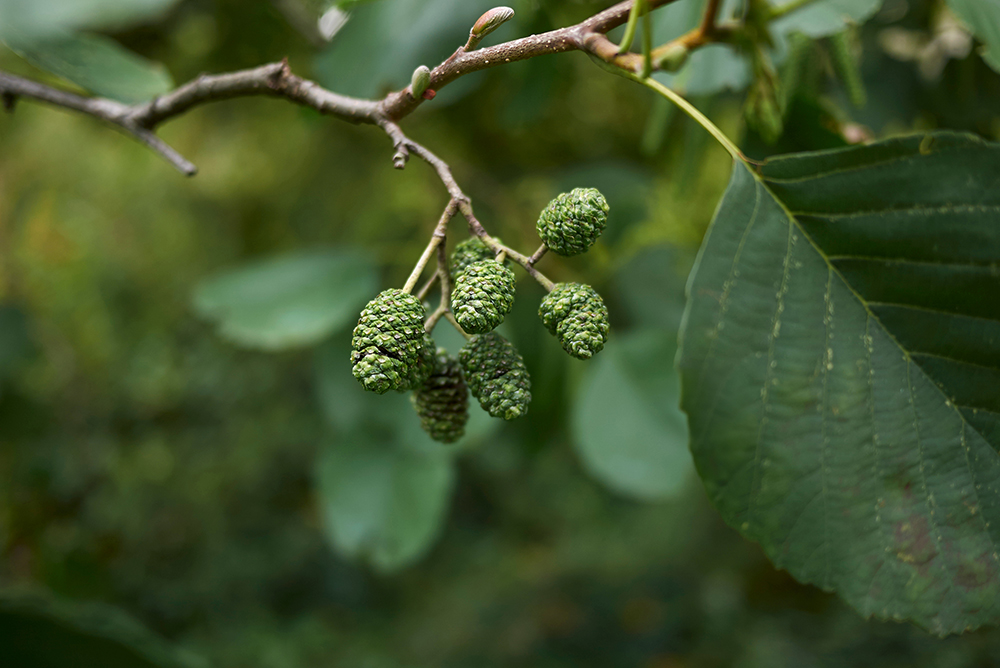
Alnus glutinosa
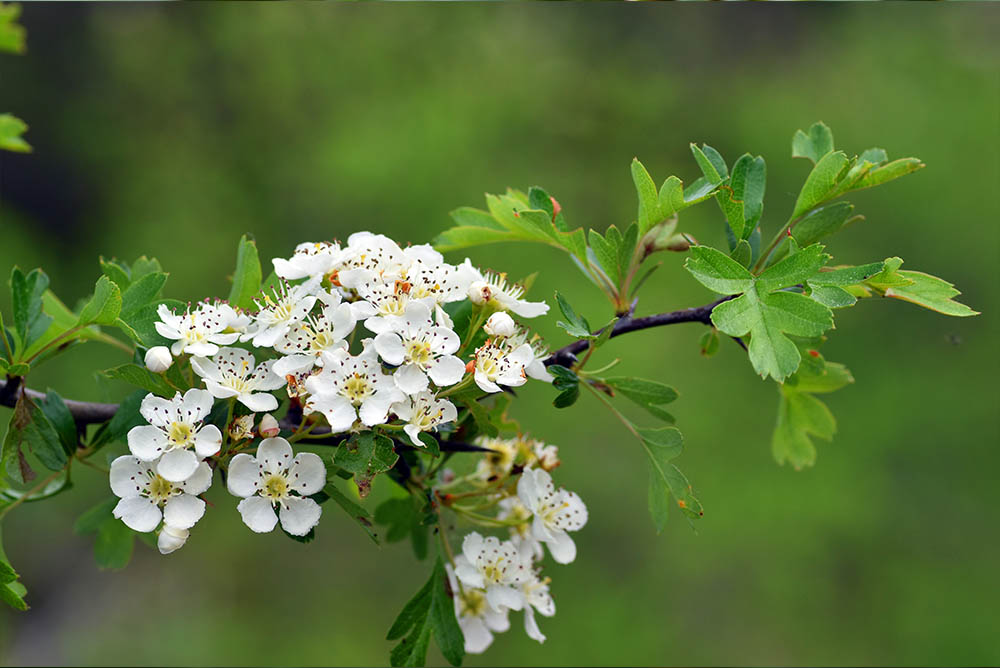
Crataegus monogyna
Sambucus nigra
Sambucus nigra is known for its ability to grow in humid areas. Its roots help stabilise the soil and improve water infiltration and It is also used in phytoremediation to remove contaminants from water.
Rosa canina
Rosa canina is a shrub that helps prevent soil erosion thanks to its extensive root system. It is also useful for improving soil structure and for the formation of humus.
Hedera helix
Hedera helix is a climbing plant with long, creeping roots, which helps to stabilise soil and prevent erosion. It is particularly useful for covering vertical surfaces and improving water infiltration. Its aerial roots improve soil stability.

Rosa canina

Hedera helix
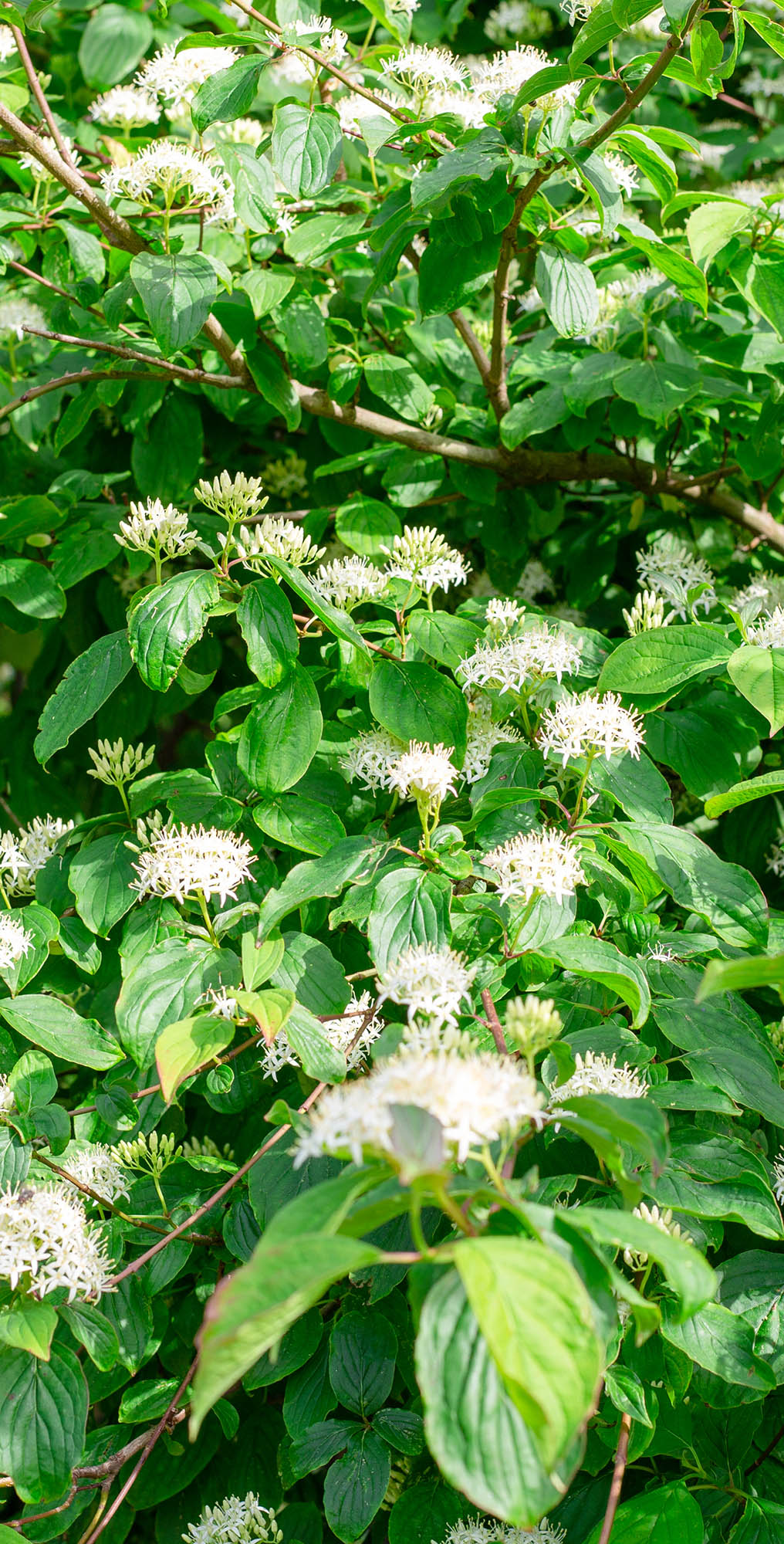
Betula pendula
If you would like to learn more about the environmental benefits of plants, read our blog here.
Human actions and local hydrological cycles
Human activities have a significant impact on local hydrological cycles, influencing the availability and quality of water resources. These include the construction of reservoirs, water tanks and basins. Although designed to improve water resource management, they can create local hydrologic cycles with both positive and negative effects.
These structures are designed to store large quantities of water, which can be used for various purposes, including irrigation, urban water supply, hydroelectric power generation and flood control. There are various types of reservoirs and water basins designed for the collection and storage of rainwater, each with specific characteristics and functions.

Storage tanks at Greenwood Plants
Storage tanks are designed to store large amounts of rainwater for future use. They can be constructed from concrete, steel, or plastic materials. Water is collected during periods of abundance and released during periods of scarcity, making them useful for urban water supply, irrigation, and flood control.
Storage basins, on the other hand, are large artificial reservoirs created by constructing dams on rivers or streams. They collect and store water during rainy periods to release it during droughts. These basins are used for irrigation, water supply, and hydroelectric power generation.
Retention basins temporarily hold rainwater to reduce surface runoff. The water is retained and released slowly, improving soil infiltration and reducing erosion.
Infiltration basins are designed to increase groundwater recharge. Rainwater is collected and allowed to infiltrate the soil, contributing to the replenishment of underground reserves.
Reservoirs and water basins regulate river flow, reducing seasonal variations and improving water availability throughout the year. This helps prevent flooding during heavy rain and mitigates drought during dry periods, providing a slow and steady supply of water throughout the year for rural and urban villages. They also can provide a source of hydroelectric power, helping to reduce the dependence on fossil fuels. Additionally, reservoirs can improve water infiltration into the soil, aiding groundwater recharge, which is particularly important in arid regions where underground reserves are a crucial water source. Despite this, the presence of large water surfaces in reservoirs increases evaporation, which can lead to significant water loss, as well as affecting local atmospheric humidity, influencing the microclimate.
The creation of water basins can alter local ecosystems, submerging natural habitats and changing river flows, with negative effects on biodiversity and aquatic habitats. They can accumulate sediment, reducing their storage capacity over time, presenting a major challenge in maintaining reservoir efficiency. The construction of large reservoirs may also require the displacement of local communities, with significant social and economic impacts.
While the construction of reservoirs is an important strategy for the management of water resources, it is essential to also consider the environmental and social impacts associated with these works. Adopting measures to mitigate the negative effects is essential to ensure sustainable management of water resources.
Synergy between plants and water infrastructures
Using plants in water infrastructure provides an innovative and sustainable approach for the management of water resources and land. This not only improves the efficiency of water infrastructure, but also contributes to biodiversity, air quality and the visual appeal of urban and rural spaces. Combining plantswith the construction of reservoirs can be accomplished through several strategies
Planting trees and shrubs along the banks of reservoirs helps stabilize the soil, preventing erosion and improving water quality; creating artificial wetlands around reservoirs can also treat wastewater and improve water quality.
Aquatic plants, as Mentha aquatica or Myosotis scorpioides, play a vital role in improving water quality. These plants absorb nutrients and contaminants, helping to purify water while providing essential habitat for wildlife. Phytoremediation is a technique that uses specific plants to remove contaminants from water, being particularly effective when using species such as salix and alnus glutinosa. These plants are able to absorb heavy metals and other pollutants from wastewater, significantly improving water quality.
Integrated land and water management projects combine different strategies to improve the sustainability and resilience of communities. These projects often involve collaboration between public and private entities and local communities.
A significant example is the IRRIGO project in Tuscany, which aims to optimise irrigation in plant nurseries, combining sustainable irrigation techniques with water resource management. The IRRIGO project is an initiative born within the Rural Development Plan of the Tuscany Region in Italy for the period 2007-2013, with the aim of optimising irrigation in nurseries.
One of the main innovations introduced by the project was drip irrigation, which allowed water savings of more than 25% compared to traditional methods. The project explored the use of water retainers, which can increase the water holding capacity of soil up to 200 times, and the use of mycorrhizae to improve the water and nutritional efficiency of plants (if you want to read more about soil fungi, read our blog here). The IRRIGO project also developed a prototype irrigation system that takes into account daily climatic conditions and the specific water needs of plants based on species and shape.
A relevant case study in the UK is the Department for Environment, Food & Rural Affairs (Defra) “Plan for Water”. Published on 4 April 2023, the plan aims to transform water system management, improve the quality of the aquatic environment and create a sustainable supply of water for people, businesses and nature. The “Plan for Water” includes a series of specific actions to achieve these objectives, such as monitoring and reducing sewage discharges, with the largest investment ever made by water companies. Transformative infrastructure projects, such as the Thames Tideway Tunnel, have been initiated to improve wastewater management, although they take time to complete. Legally binding targets have been set to reduce water pollution, as part of the new Environmental Improvement Plan. The plan has already led to positive results, such as the return of salmon to the River Don for the first time in 200 years and an increase in the quality of bathing waters in England, with more than 72% rated ‘excellent’ in 2022, compared to 51% in 2010. Additionally, many of the microplastics and single-use plastics that harm the marine environment have been banned.
Another successful example is Potsdamer Platz in Berlin, Germany, where the collection and management of rainwater are integrated with the creation of green spaces and roof gardens. This project reduced surface runoff, improved air quality and increased urban biodiversity. If you want to know more about Sustainable Drainage Systems (SuDS) read our blog here.

Potsdamer Platz in Berlin
At Greenwood Plants, we have taken a number of steps to reduce water use and improve sustainability. We use rainwater collection systems and water recycling to reduce dependence on external water resources. Additionally, we have invested in advanced technologies such as the MP2000 Rotator sprinklers, which offer water savings of up to 30%,as well as the flooded bed system at our Fresh Acres nursery. This irrigation system uses an underground tank connected to central tunnels that flood the beds for a scheduled time and at a specific height. The water is then drained, filtered and returned to the tank, allowing efficient and sustainable use of water resources. This system not only promotes plant growth and protects foliage, but also helps prevent diseases such as leaf spot.
Our long term target is to be 100% water self-sufficient across all of our UK nurseries, and we are already at 90% of this goal. Sustainability is one of our core values, and we aim to be industry leaders in demonstrating responsible planetary stewardship.
To find out more about our sustainability initiatives, click here.
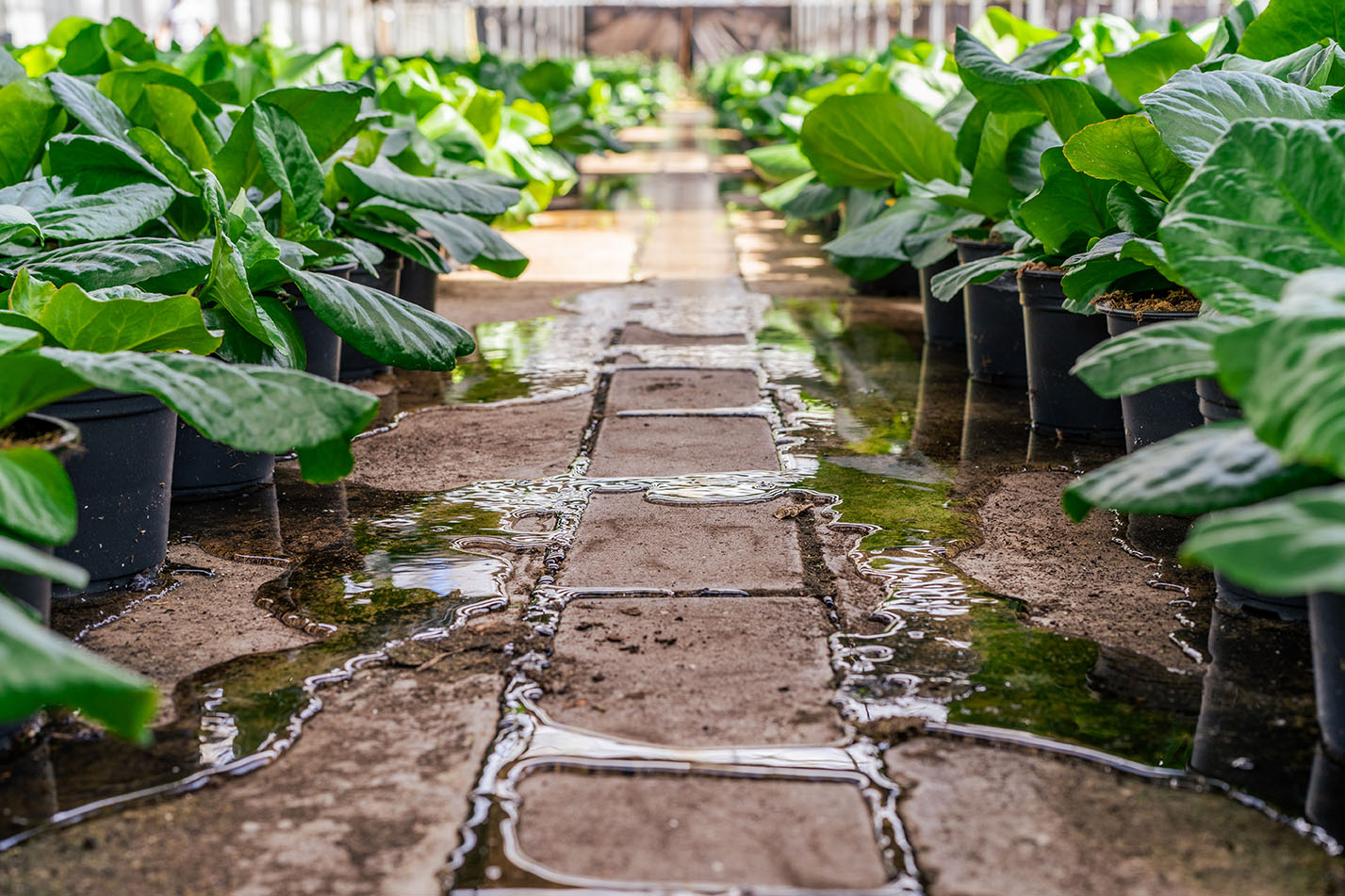
Flooding beds at Fresh Acres
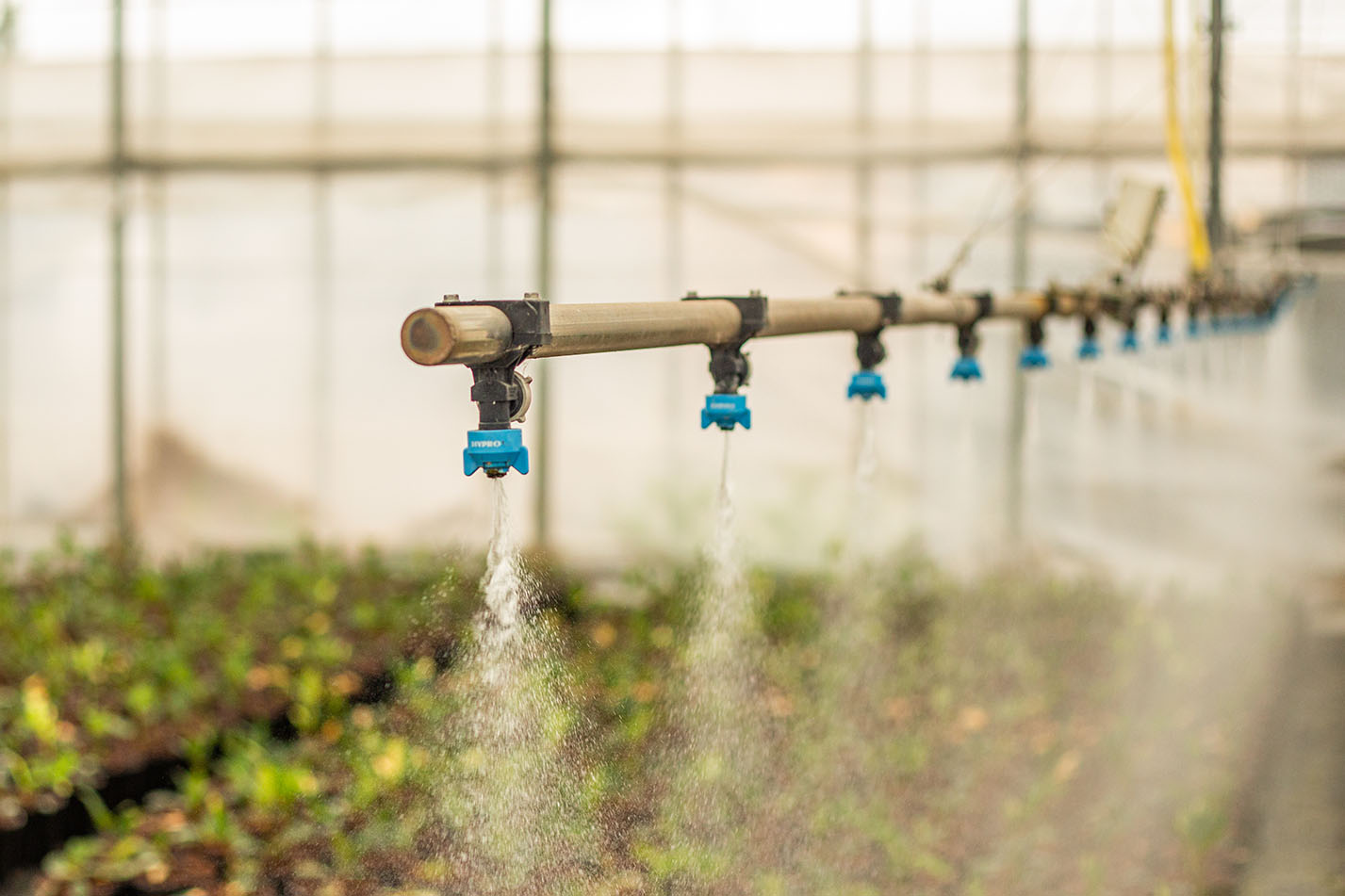
Efficient irrigation at Greenwood Plants

